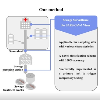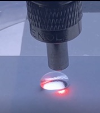Star IP Projects
June 2021 Award-winning patents from Hong Kong
The Geneva International Exhibition of Invention is one of the largest of its kind that recognises the efforts of R&D talents from around the globe every year. The 2021 edition was held online for the first time. Despite the geographical barrier, Hong Kong universities and R&D centres thrived and won acclaim at the Exhibition, impressing the community with their ground-breaking projects in different sectors, including health and medical, new textiles and materials, smart city, etc.
This issue’s Star IP Project brings to you some of the most innovative projects from Hong Kong, which may inspire you with brand new business ideas. Look no further, stay updated to the latest market trends through “Star IP Projects – Award-winning patents from Hong Kong”!
 |
 |
[Detail]
 |
[Detail]
 |
[Detail]
 |
 |
 |
[Detail]
 |
 |
 |
[Detail]
 |
 |
 |
[Detail]
 |
 |
 |
[Detail]
[Detail]
 |
[Detail]
 |
[Detail]
 |
[Detail]
 |
[Detail]
The technology is applied to distinguish real and fake edible bird’s nest by observing the absence of epidermal growth factor, five monoses and the surface morphology.
It is also able to verify different grades of edible bird’s nest by determining the content of epidermal growth factor.
[Detail]
A revolutionary technology that provides total solutions for packaging a vast array of sensitive products that are unstable in solutions. This is an important innovation in Beverage, Food, Personal Care, Pharmaceutical and Chemical Packaging Technology since the invention of plastic container closures. A patented revolutionary container closure with a delivery system that features an internal multi-cavity design that stores: liquids, powders, gases, granules or tablets.
[Detail]
Guelph researchers have developed a series of soybean lines with modified fatty acid profiles. One line from this program, RG10, is a low-linolenic type. The RG10 line and its derivatives contain less than 3 percent linolenic acid compared to 7% or greater levels present in traditional soybean varieties. The lower level reduces the need for partial hydrogenation and avoids the associated production of trans fats by that process.
[Detail]
Certain desirable water soluble food ingredients cannot easily be incorporated into foods and beverages either because they impart undesirable taste or are prone to degradation. This invention has been one suggested solution. It is a WOW double emulsion system capable of providing extended protection and improved release characteristics compared to existing systems, which widens possibilities with regards to what types of ingredients can be incorporated.
[Detail]
The invention provides a method to genetically engineer a fusion protein between a major seed storage protein and a target protein of high nutritional value so that its high level of expression and accumulation results in seeds with enhanced nutrition. The invention also extends to other edible parts of the transgenic plant or progeny thereof defined herein.
[Detail]
This technology allows accurate monitoring of temperatures in real-time thus allows more efficient management of inventories which are temperature-sensitive. Temperatures are automatically recorded and kept in database to meet Food Safety Standards Requirements.
[Detail]
With the use of silicon nanoparticles and screen printer, NAMI has developed an electronic tag with completely printed temperature sensor. This sensor can be easily customized to large-area sensor array, especially desired for chamber temperature mapping in cold chain services. The technology is beneficial for monitoring temperature-sensitive products such as wines and serves as a temperature data logger in cold chain of food and pharmaceuticals
[Detail]
This solution leverages RFID and other advanced IT technologies, such as barcode and network communications, to provide food safety, food source, and food logistics information transparently to enterprises and the public.
[Detail]
To reduce the dumping of food waste in landfill sites, HKPC collaborated with South China Agricultural University in 2007 on the development of a Food Waste Conversion System (FWCS). The FWCS can reduce the volume of food waste by 70% in 25 days, which is 58% to 72% faster than conventional compositing method.
[Detail]
This project developed a novel bioprocess which makes use of food waste for the sustainable production of poly(lactic acid) (PLA) fibre in textile industry. The process consists of lactic acid fermentation, lactic acid polymerisation and melt spinning.
[Detail]
Hydroclassification pulp fractions with a view to concentrating the mercury and radionuclides in the fine fraction for the subsequent burial of the fine fraction
|
Summary |
Mobile system for cleaning soils from radionuclides, mercury and other heavy metals. At the heart of the complex lies hydroclassification method
|
|
Technology Benefits
|
Low-waste non-chemical treatment technology |
|
Technology Application |
Cleaning up of soils contaminated with radionuclides, mercury and other heavy metals
|
|
Detailed Technology Description |
Mixing contaminated soil with water. Hydroclassification pulp fractions with a view to concentrating the mercury and radionuclides in the fine fraction for the subsequent burial of the fine fraction.
|
|
Application Date |
28-Sep-2015
|
|
Application No. |
RU2014132935
|
|
Patent Information |
PCT/RU2015/000557
|
|
Others |
integrated treatment of soil-ground contaminated with mercury (amalgam) and/or radionuclides
|
|
ID No. |
RU2562806
|
|
Country/Region |
Russia |
Hong Kong Productivity Council developed a recycling system employing Submerged Aerated Filter (SAF) to decompose organic matters in wastewater by special micro-organisms which are retained in the system by micro-filtration (MF). After disinfection, the recycled water is crystal-clear, free of germs and odour, which can be used for toilet flushing, gardening or as cooling tower make-up water.
|
IP Title |
中水回用系統
|
|
Summary |
Greywater is a part of domestic wastewater, including wastewater from washing basins, baths, and washing machines, but excluding toilet waste. Due to the continuous development of treatment technologies, greywater and domestic wastewater can now be recycled cost-effectively through advanced techniques. Recently, HKPC developed a recycling system employing Submerged Aerated Filter (SAF) to decompose organic matters in wastewater by special micro-organisms which are retained in the system by micro-filtration (MF). After disinfection, the recycled water is crystal-clear, free of germs and odour, which can be used for toilet flushing, gardening or as cooling tower make-up water. Video Link to Youtube: https://youtu.be/FccbRlFcy5o?list=PL3ubiSM-v1GBtxp1IHrH2Cj7TljFM_hEb
|
|
Type of Cooperation |
Licensing
|
|
Application Date |
13/07/2007
|
|
Application No. |
HK1095980
|
|
Coverage Areas |
Green Technology
|
|
Country/Region |
Hong Kong
|
|
Summary |
The textile industry is an energy-intensive business. Energy cost occupies the highest proportion of the total cost during production. The establishment of energy consumption and production data management systems enables enterprises to better understand their energy consumption status.
|
|
Technology Benefits |
Technological Breakthrough - Real-time system: The system can provide real time energy consumption and production status information with visual-user-interface. It also provides traceability and alerts functions.
|
|
Technology Application |
The system is composed of a control panel equipped with keypad, radio frequency identification tags and tag reader, a wireless sensor network and a wireless meter data acquisition device.
|
|
Detailed Technology Description |
A non-exclusive licence includes the right of making further research and development as well as sale of the system based on the filed patent.
|
|
Country/Region |
Hong Kong |
|
Summary |
A durable catalyst developed for green biodiesel production from low grade feedstock through one-step catalysis
|
|
Technology Benefits |
One-step biodiesel production from low grade unrefined feedstock; No washing with fresh water required for biodiesel produced; Operates at low temperature and pressure; The catalyst demonstrates excellent reusability and robustnes
|
|
Technology Application |
Biodiesel production
|
|
Detailed Technology Description |
Biodiesel is a sustainable liquid fuel originated from biomass. However, traditional liquid biodiesel catalyst generates a huge amount of waste water in the final purification procedure. A new class of solid catalyst is developed by precise surface chemistry engineering to catalyze the biodiesel production. With excellent adaptability to low grade unrefined feedstock like waste cooking oil, the catalyst can provide complete solution to the waste water problem. In addition, it operates at a significant lower temperature and pressure as compared with the existing solid biodiesel catalyst due to its high catalytic activity, which can reduce the energy and cost required for biodiesel production
|
|
Application Date |
26/03/2015
|
|
Application No. |
62138963 (HK)
|
|
Goods and Services |
Biotech & Life Science
|
|
Source |
Biodiesel Catalyst
|
|
Country/Region |
Hong Kong |
|
Summary |
Fuel costs are one of the largest operational expenses for rail transport. The cost of the energy acquisition for one freight locomotive is from $700K to $1,2M per year. To address this problem, OptiRail Ltd. has developed the Smart Automatic Train Operation (SATO®) system. SATO automatically controls the train, similar to an aircraft autopilot, while reducing energy consumption used for traction by 10 to 25%
|
|
Technology Benefits |
Technology allows optimization of train operation based not on averages or general conditions, but on exact current train and external conditions
|
|
Technology Application |
Reduce the operation cost operators/owners of railways locomotives up to 25% and reduce carbon emissions
|
|
Detailed Technology Description |
Techology is designed for the optimal control computation with minimal electric energy (diesel fuel) consumption used for the locomotive traction. It allows determination of the actual characteristics of the train and external conditions while the train is in motion, using available information in digital locomotive network:
|
|
Application Date |
30-Mar-2015
|
|
Application No. |
RU 2014112992, EA 201400515
|
|
Patent Information |
PCT/RU2015/000199
|
|
ID No. |
RU № 148444
|
|
Country/Region |
Russia |
|
Summary |
In recent years, indoor air quality has become an important issue in Hong Kong, China and in many other countries. Numerous indoor sources emit a low concentration of volatile organic compounds (VOCs), which cause adverse health effects such as allergic reactions, tiredness, and even cancer. Considerable effort is spent on aligning industrial practice with government regulatory requirements. The adsorption based air purification technology transfers the VOCs to another phase rather than eliminating them, thus leading to the problem of additional disposal and waste treatment.
|
|
Application Date |
08/10/2010
|
|
ID No. |
12/900,768
|
|
Country/Region |
Hong Kong |
|
Summary |
As in many cosmopolitan cities in the world, the high-density buildings and roads generate great environmental burdens in Hong Kong. For instance, air conditioning inside buildings accounts for one-third of the total local electricity consumption. Recent developments of green and energy efficient building materials shed light on tackling such environmental issues.
|
|
Technology Benefits |
. Light-weight with high compressive strength
|
|
Technology Application |
.External walls and internal wall partitioning of buildings |
|
Summary |
Two novel phosphorus recovery processes, which effectively enable the reuse of recovered phosphorus as a resource, have been developed. These processes have been designed with full consideration given on the specific characteristics (sewage components, chemical concentrations, flow rates, etc.) of wastewater or sludge generated from sewage treatment. The first of these processes, named Rephosmaster CS, features the treatment of wastewater with high concentrations of suspended solids, such as that containing anaerobic digested sludge. The other, named Rephosmaster FB, is for the same with low concentrations of suspended solids, such as filtrate from dewatering machines and recycle flow. These processes have been proven effective for not only recovering phosphorus as a resource, but also for the prevention of eutrophication which may result from residual nitrogen and phosphorous in the effluent.
|
|
Technology Benefits |
Rephosmaster (TM) CS, features the treatment of wastewater with high concentrations of suspended solids, such as that containing anaerobic digested sludge. The other, named Rephosmaster FB, is for the same with low concentrations of suspended solids, such as filtrate from dewatering machines and recycle flow. These processes have been proven effective for not only recovering phosphorus as a resource, but also for the prevention of eutrophication which may result from residual nitrogen and phosphorous in the effluent.
|
|
Type of Cooperation |
License, R & D Contract or Research Collaboration
|
|
Coverage Areas |
Land, Water, Air
|
|
Goods and Services |
Waste management > Treatment of waste
|
|
ID No. |
PCT/JP2006/300947,PCT/JP2002/010596 |
|
Summary |
The heart of this new chemistry is the technology used to create a colloidal micelle. This technology presents a highly concentrated bio-based cleaning product which utilizes the unique properties of colloidal micelles in order to tackle almost any kind of cleaning situation. The micelle molecules are able to break down organic molecules such as hydrocarbons and can be formulated into effective cleaning, degreasing, emulsifying and encapsulating agents. Each micelle measures one nanometer across which is equivalent to the size of ten hydrogen atoms. The encapsulation action of these nano-scale molecules enable then to penetratr through and emulsify hydrocarbons such as wax, grease or oil and remove stains. These micelles offer inherent advantages over traditional chemicals in reduced application rate, more rapid and reliable activation and extended long-term effect.
|
|
Technology Benefits |
Colloidal holding properties to prevent re-deposition of dirt & greaseDiverse applications in various industries Time, labour & cost savingsPrevents multiple chemical sensitivity High dermatological safety, no hand gloves or protective clothing required100% bio-based, non-toxic & biodegradablenon-fuming, non-flammable & environmentally friendly
|
|
Technology Application |
This remarkable technology provides a platform for various cleaning formulations with a broad spectrum of applications ranging from food processing to industrial and commercial cleaning. It is also highly effective for a myriad cleaning applications in industries such as automotive, marine & offshore, janitorial maintenance, manufacturing, hospitality, medical care, schools and food & beverage processing. It can be formulated to work with a variety of surfaces, including metal, plastic, fabric, vinyl, rubber, painted surface, and even leather.
|
|
Detailed Technology Description |
Micelles are extremely sub-microscopic and electrically charged particles that repel each other like opposing magnets in a ceaseless random movement, when activated in water. Each micelle has an opposite charge, one hydrophilic a hydrophilic (water-seeking) head and a hydrophobic (water-repelling) tail. The hydrophobic tails attract each other, thus forming the centre of the micelle while the hydrophilic heads aggregate to form the outer, charged surface.These micelles repel each other while penetrating dirt, greases and oils that they come contact with. When a micelle comes into contact with hydrocarbons or other highly viscous and sticky materials, the center of the micelle bonds to the substances. This encapsulation action enable them to penetrate through and locks the substances in colloidal suspension, lifting them from the surface to which they were adhered. Thus this, technology can be formulated into effective and versatile cleaners that act by disrupting the attraction between viscous, sticky, hydrocarbon based spills and the surface.
|
|
Application Date |
07-Sep-2015
|
|
ID No. |
TO17866
|
|
Country/Region |
Singapore |
|
Detailed Technology Description |
A wind-powered electricity generator has been developed that utilizes wings to efficiently capture the energy of low or high speed winds. The wings are positioned horizontally and oscillate around a central axis. This wind-powered generator provides numerous advantages in manufacturing, operation and efficiency in comparison to the wind, turbine generators presently favored for electrical generation.
|
|
Abstract |
Government and industry have aggressively pushed the development of wind turbine technology. Horizontal-axis wind turbines (HAWT) have been widely adopted for commercial power generation, while there are numerous issues that decrease the cost-efficiency of medium and large size HAWT. Because aerodynamic force is proportional to the wing area of a blade, it is difficult to maximize the effective wing area of a rotating blade as the size of the blade increases. The turbine blades must be long and slender, particularly near their tips to reduce centrifugal force and maintain structural integrity. This limits the effective wing area near the tip of the blade, where a considerable amount of aerodynamic torque is normally generated. Installation of long slender blades on a large-sized HAWT is particularly difficult, and requires special equipment that may not be easily operated in certain terrain. Contamination from dead bugs and birds near the leading edges of blades can reduce their aerodynamic efficiency by 50%, and cleaning the blades is not an easy task.
|
|
Country/Region |
USA |




